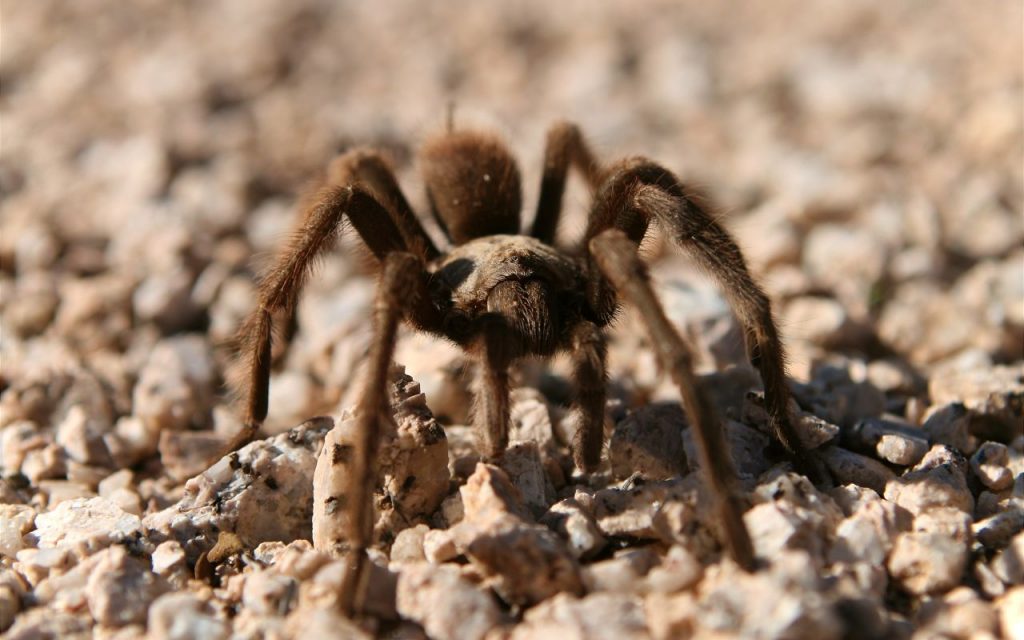Last updated on February 1st, 2023 at 09:54 am
Tarantulas are often sexually dimorphic, with males being physically different. As you’re about to find out, male Arizona Blonde Tarantulas are no exception…
The Arizona Blonde Tarantula (Aphonopelma chalcodes) is a familiar species in the American southwest, and is also sometimes referred to as the Desert Tarantula. Like in most species of tarantula, the males are smaller and slimmer than the females. They also have much darker coloration, however, making them look like a different species altogether.
A Male Arizona Blonde Tarantula will have black legs. The abdomen of male tarantula will be reddish and they also have cephalothorax in copper color.
Most striking though is how long and skinny their legs look compared with those of the females. They are much lighter in build, and spend a lot more time wandering in search of mates.
The burrows of male insects can be as big as 25 to 50 mm in diameter. You can also find some strands of silk across the opening of burrows.
In this article, we’ll look at these details and more, so that you can correctly identify a male Arizona Blonde.
How can I tell if my Arizona Blonde Tarantula is Male or Female?
When you see a lady tarantula, you will find that she has a more stocky body as compared to a male tarantula. Also, the body of female tarantulas is protected by tan or light brown hair.
Due to the bodily feature of this creature, it is referred to as a blond tarantula. Male tarantulas, on the other hand, will have thinner bodies.
Further, the body of a male tarantula will be lankier with black hair covering most of the body. You can differentiate a male tarantula with reddish hairs in its abdomen.
Example of a typical male Arizona Blonde:

Example of a typical female Arizona Blonde:

How Long do Male Arizona Blondes Live?
As compared to female tarantulas, the lifespan of male tarantulas is lesser. Male tarantulas live for 5-10 years on average.
Also, male insects pass away very quickly after they mature. They mate in summer with female tarantulas and do not survive long after copulation.
They do not live more than 1.5 years after maturity. You might wonder how they die.
- At times, female tarantulas make a meal out of their male partner.
- Another predator also can kill male tarantulas.
- In some instances, excessive exposure to cold and heat can also kill them.
- Naturally, males can survive only a few months after copulation.
How Big do Arizona Blondes Get?
After gathering these many details about male Arizona blond tarantulas, you might feel that females are blessed. Yes, even in size, females have a better edge as compared to males.
When the males can reach up to 44 mm body length, females can reach up to 56 mm.

Why do Tarantulas Tap Their Legs?
Male tarantulas attain maturity when they are 10 to 12 years old. At this age, they leave their burrow to find a lady tarantula for mating.
When he finds a burrow of a mature female, who is more than 10 years of age, the male will announce his arrival. He will do this by tapping at the entrance of the burrow of the female.
He will do this tapping in specific sequences at which he gets a response from the female. If she is ready to listen, she will signal her permission for the male to enter her burrow.
As mentioned earlier, male tarantulas are smaller in size. Also, females have venom that is deadly to males. Due to this reason, the male will be careful when approaching the female for mating. Once he deposits his sperm on her, he will let her go.
But, for carefully depositing the sperm, he will hold the female above him. He will use the spur located in his pair of legs behind the knees for this purpose.
Immediately after sperm deposit, he will make a rapid retreat. The reason is that the females, in most instances, make the male their meal after mating. Again, you will feel sorry about the male tarantulas now. But, this is what naturally happens among this creature.

Do Arizona Blonde Tarantulas Spin Webs?
Arizona blonde tarantulas do not build webs. However, they spin spider silk.
They use spider silk for creating an entrapment at the entrance of their burrows. With this, they attract potential prays.
This is why you can often see the borrows of these insects covered with multiple silk threads.
How Can you Tell How Old a Tarantula is?
Many people these days show interest in growing Arizona blonde tarantulas as their pets. When growing as a pet, you should remember that there can be huge differences in the size of this insect.
The size can be drastically affected when you keep them in extremely low or high weather. Even, the way you feed them will decide their size.
When you wish to grow this insect as your pet, you should get one at a younger age. Unfortunately, it is hard to tell the age of these insects with their size.
Here are some ideas to check whether the tarantula is young:
- It is better to take females as pets as they live longer than males.
- If you wish to choose a male, it is better to choose an immature tarantula.
- In a male, look at the pedipalps. These are sometimes referred to as fangs.
- In case, these pedipalps are bulbous and large, it is an indication that the male has matured. Look at the tibial spurs that you can find in the front legs of tarantulas as signs of maturity.
- If the insect is male and is yet to mature, it will be around 2 to 5 years old. In case, a male tarantula does not show bodily signs of maturity, it will be around 4 to 6.5 years of age.
- If the tarantula is a yet-to-mature female, its age will be around 2 to 5 years. A mature female can be between 2 and 38 years.

Do Arizona Blonde Tarantulas Burrow?
Yes, tarantulas burrow as they are a category of burrowing spiders. They burrow as they live underground. In most cases, they burrow themselves. Also, some tarantulas use an abandoned burrow as their home.
When they burrow their nest for themselves, they do it using their flangs. They burrow during the molting process. When the shedding time is fast approaching, larger specimens of tarantulas hide. They do this to get a sense of safety during shedding season.
As the molting can be highly taxing for these insects, they hide in burrows at this time. When you see discarded insect carcasses with debris in the entrance, it is a tarantula burrow.
These insects line their burrows using silk. The purpose of this act of tarantulas is to attract prey. When prey gets near the burrow, the silk will vibrate. It will signal the insect living inside. The silk threading at the entrance also safeguards tarantulas at the time of extremely hot climatic conditions.
Tarantulas live in desert areas of Arizona. Nevertheless, they exist in other areas of the state as well. They build deep borrows in suitable soil and line the opening of the borrow with silk webbing to prevent occupation by other insects. This webbing also helps to catch the prey so that it can skip a night of hunting.
In case, the insects identify the non-availability of appropriate soil, they will burrow into logs, rocks and even in cacti at times.
Why is my Tarantula Always on the Glass?
You might have been growing a young tarantula for which you have provided borrow at the base of a glass tub. But, if you are frequently seeing your tarantula leaving its burrow and sitting on the glass, here are some reasons:
- It might need food and water.
- Your tarantula might need better anchor points for webbing
- It might have matured and so it might be seeking out a mating partner.
- The present borrow might not be satisfying and in this case, the tarantula might be looking for a better place to hide.
- He/she might be restless due to a new atmosphere.
- At times, the size of the enclosure can make your tarantula restless.
- You can understand whether your tarantula is hungry from the size of the abdomen. In case it is still plump, hunger is not the reason for the restlessness.

FAQ relating to Male Arizona Blonde Tarantula information
Can you Pick up an Arizona Blonde Tarantula?
Yes, you can pick them up. They are creatures that do not mind a small amount of handling.
However, they mostly love to be left alone. All you should do is feed them with the recommended cricket diet and set them in appropriate habitats.
Once these things are done, they will lead a happy life for longer.
Are Arizona Blonde Tarantulas Nice?
After seeing many people owning Arizona Blonde Tarantulas as their pets, you might think something. Yes, you might wonder whether they are nice for petting.
The good news to you is that hands down, these are the best species for those beginning petting for the first time. The reason is that they are the most tolerant in handling.
Also, their calm disposition, make them the best creatures for petting.
Do Arizona Blondes Kick Hair?
Indeed, Arizona Blondes are known for their better temperament and docile nature. But, some of them kick hair as well as a defense mechanism.
It is nothing but tarantulas rub hair from their abdomen as a technique to safeguard themselves from harm. So, when you are adopting one for the first time, it is better to be careful initially.
Do Arizona Blonde Tarantulas Need a Heat Lamp?
You might be aware that this species comes from an arid atmosphere. So, it does not need any lighting or heating.
There will not be any issues unless your house temperature goes beyond 65 to 80 degrees F.
But, if the temperature gets lesser than this, it is better to use a small portable heater such as a very low wattage heat mat, i.e. 5 watts. Even this should be used with caution, and only placed on the side of the enclosure so it can’t dry out the substrate too much.







